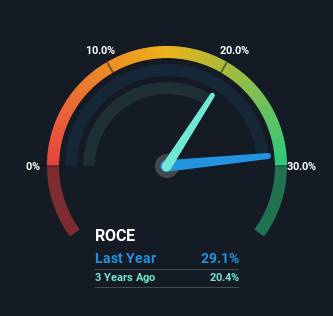- India
- /
- Electronic Equipment and Components
- /
- NSEI:REDINGTON
Redington (NSE:REDINGTON) Is Achieving High Returns On Its Capital
What trends should we look for it we want to identify stocks that can multiply in value over the long term? Amongst other things, we'll want to see two things; firstly, a growing return on capital employed (ROCE) and secondly, an expansion in the company's amount of capital employed. This shows us that it's a compounding machine, able to continually reinvest its earnings back into the business and generate higher returns. With that in mind, the ROCE of Redington (NSE:REDINGTON) looks great, so lets see what the trend can tell us.
Understanding Return On Capital Employed (ROCE)
For those who don't know, ROCE is a measure of a company's yearly pre-tax profit (its return), relative to the capital employed in the business. Analysts use this formula to calculate it for Redington:
Return on Capital Employed = Earnings Before Interest and Tax (EBIT) ÷ (Total Assets - Current Liabilities)
0.29 = ₹20b ÷ (₹214b - ₹144b) (Based on the trailing twelve months to December 2022).
Thus, Redington has an ROCE of 29%. That's a fantastic return and not only that, it outpaces the average of 8.3% earned by companies in a similar industry.
See our latest analysis for Redington

Above you can see how the current ROCE for Redington compares to its prior returns on capital, but there's only so much you can tell from the past. If you'd like to see what analysts are forecasting going forward, you should check out our free report for Redington.
SWOT Analysis for Redington
- Debt is well covered by earnings.
- Dividend is in the top 25% of dividend payers in the market.
- Earnings growth over the past year underperformed the Electronic industry.
- Annual earnings are forecast to grow for the next 4 years.
- Good value based on P/E ratio compared to estimated Fair P/E ratio.
- Debt is not well covered by operating cash flow.
- Paying a dividend but company has no free cash flows.
- Annual earnings are forecast to grow slower than the Indian market.
What The Trend Of ROCE Can Tell Us
We like the trends that we're seeing from Redington. The data shows that returns on capital have increased substantially over the last five years to 29%. The company is effectively making more money per dollar of capital used, and it's worth noting that the amount of capital has increased too, by 87%. So we're very much inspired by what we're seeing at Redington thanks to its ability to profitably reinvest capital.
On a side note, Redington's current liabilities are still rather high at 68% of total assets. This can bring about some risks because the company is basically operating with a rather large reliance on its suppliers or other sorts of short-term creditors. Ideally we'd like to see this reduce as that would mean fewer obligations bearing risks.
The Key Takeaway
In summary, it's great to see that Redington can compound returns by consistently reinvesting capital at increasing rates of return, because these are some of the key ingredients of those highly sought after multi-baggers. Since the stock has returned a staggering 179% to shareholders over the last five years, it looks like investors are recognizing these changes. In light of that, we think it's worth looking further into this stock because if Redington can keep these trends up, it could have a bright future ahead.
One more thing to note, we've identified 1 warning sign with Redington and understanding it should be part of your investment process.
Redington is not the only stock earning high returns. If you'd like to see more, check out our free list of companies earning high returns on equity with solid fundamentals.
New: AI Stock Screener & Alerts
Our new AI Stock Screener scans the market every day to uncover opportunities.
• Dividend Powerhouses (3%+ Yield)
• Undervalued Small Caps with Insider Buying
• High growth Tech and AI Companies
Or build your own from over 50 metrics.
Have feedback on this article? Concerned about the content? Get in touch with us directly. Alternatively, email editorial-team (at) simplywallst.com.
This article by Simply Wall St is general in nature. We provide commentary based on historical data and analyst forecasts only using an unbiased methodology and our articles are not intended to be financial advice. It does not constitute a recommendation to buy or sell any stock, and does not take account of your objectives, or your financial situation. We aim to bring you long-term focused analysis driven by fundamental data. Note that our analysis may not factor in the latest price-sensitive company announcements or qualitative material. Simply Wall St has no position in any stocks mentioned.
About NSEI:REDINGTON
Redington
Distributes information technology, mobility, and other technology products in India, the Middle East, Turkey, Africa, and South Asian countries.
Solid track record with adequate balance sheet and pays a dividend.
Similar Companies
Market Insights
Weekly Picks

Solutions by stc: 34% Upside in Saudi's Digital Transformation Leader


The AI Infrastructure Giant Grows Into Its Valuation
Recently Updated Narratives


The Industrialist of the Skies – Scaling with "Automotive DNA


The "End-to-End" Space Prime – The Only Real Competitor to SpaceX


De-Risked Production Ramp with Exceptional Silver Price Leverage
Popular Narratives


MicroVision will explode future revenue by 380.37% with a vision towards success


NVDA: Expanding AI Demand Will Drive Major Data Center Investments Through 2026



